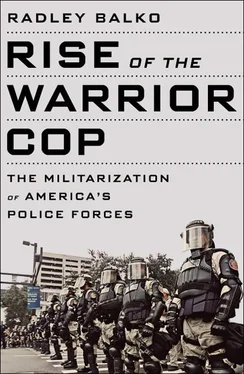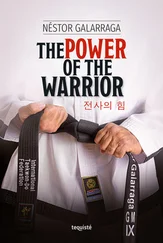Minikus called to have Frye’s car impounded, and Frye appeared ready to comply with his imminent arrest. But when Frye’s mother, Rena Frye, arrived at the scene, the tenor of the arrest changed. Frye’s mother excoriated him in front of the growing crowd. Frye grew embarrassed, then angry. When Minikus tried to put him into the car, he resisted. When another officer who had arrived swung to hit Frye in the arm with his baton, Frye ducked, and it struck him in the eye. Ronald Frye, Marquette Frye’s brother, then punched Minikus in the kidney and Rena Frye jumped on his back. More Los Angeles police officers arrived. After more scuffling, all three members of the Frye family were arrested. The crowd turned angry. As the police put the Fryes into the backs of squad cars, a member of the crowd allegedly spit on one of the police officers. She too was arrested. According to the police, she too resisted. That only further angered the crowd. As they drove away, Marquette Frye would later say, a friend of his who had joined the crowd shouted to him, “Don’t worry, we’re going to burn this mother down.”
Watts burned for six days. The riots were different from the unrest that had broken out on the East Coast in the previous year. For one thing, while Watts could be a rough neighborhood and had some poor areas, it wasn’t the sort of cramped, crushingly poor ghettos found on the East Coast. Though Watts itself was quite small (about one square mile at the time), the riots spread well beyond its boundaries, eventually covering forty-six square miles. And where previous riots had tended to erupt and then persist in fairly concentrated areas, the Watts rioters were disbursed, random, and disorganized. Once Watts exploded on the night of August 11, 1965, the next five nights were a series of quick flashes and slow burns. Violence would die down in parts of the city, only to flare back up in others. Snipers took positions in elevated windows, then tried to pick off cops, firemen, and pedestrians. Looting and arson were rampant. Yet unlike many previous racial riots, no US military troops were sent to Watts. Instead, on the third night, the state dispatched 13,500 California National Guard troops, who remained under the command of the Los Angeles Police Department (LAPD) for the duration of the rioting. 11
Frye’s arrest was, of course, only the precipitating incident. The riots were the culmination of years of animosity between black Angelenos and the LAPD administration of Chief William Parker. Black rioters took aim mostly at white cops, motorists, and firemen. Looting was directed mostly at white-owned businesses. Parker didn’t help the situation when he compared the rioters to “monkeys in a zoo.” 12By the time they finally died down, the Watts riots ranked among the most destructive in American history. The rioters caused $40 million in losses, damaged or destroyed one thousand buildings, and left more than one thousand injured and thirty-four dead. At least four thousand people were arrested.
In a couple of ways, the Watts riots were the first major incident to nudge the United States toward more militaristic policing. First, Watts made middle America begin to fear crime as never before. Much of white, middle-class America spent five nights watching their TVs as black people looted and burned their own neighborhoods. To them, Watts and the riots in Baltimore, Newark, Washington, and Detroit in the following years were signs of a rising criminal class that was increasingly out of control. The political clout of what Nixon would a few years later call “the Silent Majority” would influence a generation of crime policy geared toward giving police more power, more authority, and permission to use more force.
But Watts also had a more direct consequence. The LAPD’s point man during the riots was thirty-nine-year-old inspector Daryl Gates, who had been ascending the ranks of the LAPD like a Gemini pilot. The riots left Gates feeling that police training and tactics at the time were inadequate to address the sort of threat posed by the snipers, rioting, and violence he witnessed in Watts. “We had no idea how to deal with this,” Gates writes in his autobiography. “We were constantly ducking bottles, rocks, knives, and Molotov cocktails…. Guns were pointed out of second-story windows, random shots fired…. It was random chaos, in small disparate patches. We did not know how to handle guerrilla warfare. Rather than a single mob, we had people attacking from all directions.” 13
At the time, the US military’s foe in Vietnam was using real guerrilla warfare. So Gates thought to ask the military for guidance. There he found not only the tactics and training he thought could help put down the next wave of rioting, but also the inklings of what would become his most enduring legacy.
Gates would create a phenomenon that over the course of his career would reach virtually every city in America. It would change the face, the mind-set, and the culture of US policing from the late 1960s on, through today, and probably into the foreseeable future.
He started America’s first SWAT team.
IN SEPTEMBER 1953, PRESIDENT DWIGHT EISENHOWER nominated Earl Warren to be chief justice of the Supreme Court. He’d later call it one of his greatest mistakes. Warren was a former district attorney, attorney general, and three-term governor of California. He was also the federal official who oversaw the internment of Japanese Americans in California during World War II. He seemed an unlikely candidate to build a consensus on the Court to protect the rights of the accused—which probably made his critics all the angrier when he did.
The first major criminal justice decision from the Warren Court was Mapp v. Ohio in 1961. Police in Cleveland suspected that Dollree Mapp had some evidence hidden in her house related to a bombing and a gambling ring. When she refused to let them in, they showed a fake warrant, forced their way inside, and searched her home. They didn’t find the evidence they were looking for, but they did find some illegal pornography. She was arrested, charged, and convicted. The police never did produce a search warrant. The Court ruled that the Fourth Amendment’s protection from unreasonable search and seizures applies to the states through the Fourteenth Amendment. And under the 1914 case Weeks v. United States , evidence seized in an illegal search could not be used at trial. Police in every jurisdiction in the country were now obligated to uphold the Fourth Amendment. 14
The next year the Court found in Robinson v. California that incarcerating someone merely for being addicted to drugs is a violation of the Eighth Amendment. 15Two big cases followed in 1963. In Gideon v. Wainwright the Court ruled that states are obligated to pay for an attorney for indigent defendants, 16and in Brady v. Maryland it ruled that prosecutors must turn over exculpatory or mitigating evidence to defendants when the evidence is material to guilt or to the defendant’s sentence. 17
In 1964 the Warren Court ruled that suspects have the right to an attorney, not just at trial, but during police interrogations as well. 18The famous Miranda decision came in 1966, which held that police must notify suspects of their Fifth Amendment rights against self-incrimination, and to be represented by an attorney. 19The decision was widely derided by conservatives. It wasn’t particularly popular with the general public either. It quickly became a rallying cry for the law-and-order crowd, who were appalled at the notion that the police could be required to tell suspects that they weren’t obligated to answer their questions.
The Warren Court’s final controversial decision, at least from the law-and-order side, was Katz v. United States in 1967. 20In that case, the Court expanded the Fourth Amendment’s protections from “unreasonable search and seizure” to the broader standard of “a reasonable expectation of privacy.” In practical terms, the Fourth Amendment would no longer be limited to physical intrusions. If law enforcement officials wanted to tap a phone, for example, they would need to get a search warrant.
Читать дальше













